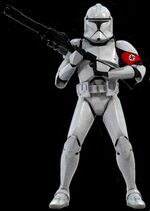Panzers
- Note: This page will not merge with the page on nazism. Please do not confound the two. Maybe some day it will conquer or destroy it. But all things in due time.
“GET THE WHITE FLAGS OUT, QUICK!!! ”
“FOR THE MOTHERLAND AND I AM GOING TO HEAVEN!! ”
Panzer is the German word for Tank, PanzerKampfWagon also means Tank in German and KrankenKreigPanzerKampfSlitterBahnWagon also means Tank in German, correct usage and diction are of course left to a myriad of bizzare German grammar rules that you should seriously stay away from, so for simplicity's sake Panzer will do for now.
History[edit]
The first German tanks were called tractors, and were cheap copies of British tanks. However the Germans quickly realized that the British don't really know how to do anything, and began to experiment on their own. So they began to create larger and better "Tractors".
When Adolf Hitler came to power in 1933 he decided to drop the bogus tractor designation and openly defied the Treaty of Versailles by producing Panzers. The French responded by doing what they do best, absolutely nothing, after all they had that impenitrable defensive fortification The Maginot Line that stretched from Switzerland to Belgium. The Panzers using their ability to move forward and steer, simply went around the walls of the Maginot line. And for the near 1000th time in history conquered the French.
First Modern Usage[edit]
13 of June 1938. The first day that the Panzers rolled across the Polish Border (coincidentally they also rolled a natural 20 at their attack check). Their first action was parking next to the border, and letting the infantry fight the Polish. The Polish fought primarily using grenades, but the Germans retaliated by pulling the pins out and throwing them back. The Panzers only began to contribute when the Polish began to run out of Grenades. They then used their secret weapon: Cavalry. Charging German tanks with Rifle and Sword they sought to defeat the German armor in hand to hand combat. The Tanks merely opened fire with their machine guns and simply ran over the horses using their tanks.
Panzer I, II, III, IV, V(and VIII)[edit]
- The Panzer I was the first Panzer manufactured by Krupp in Nazi Germany in 1936. It had a machine gun, and an extremely angry face painted on the front. This machine would prove instrumental in the downfall of the Polish only a few years later. Especially as the Polish often couldn't understand that the Tanks weren't Demons but merely machines used by the Germans.
- The Panzer II was a far more complex machine that included both the previous Machine gun along with the extremely angry face. The Primary change between the two was the introduction of Flame Decals that made all Panzer drivers feel like they were going really fast. It was also instrumental in Poland because the Polish thought they were attacking them so fiercely that the ground was erupting into flames.
- The Panzer III Was the first Panzer to include a cannon on it, that was primary used only for the two tanks that the Polish had, and later the single British Garrison that defended France. It had the previous decals, as well as a machine gun. This was the most feared of all the Panzers up until the Panzer IV came out. It was used against Russia with good effect and was the only part of the war in which it fired more then 3 shots. However, as the war in the east prgressed, commanders of these tanks were annoyed at the 'lack of armour' on these tanks, as they could still feel faint vibrations from the most powerful soviet AT guns. Also, the cannon was claimed to be 'ineffective' against russian tanks despite being able to level a small town (had they fired a high explosive shell).
- The Panzer IV was the biggest and baddest out of all the panzers, being built from cannonballs, blood, and evil, and using Prussian drivers they were known for having a giant main cannon, flame and Angry Face decals, machine gun, And a coffee Maker. This ensured that the Prussians would never tire out in face of the enemy, and caused many sleepless nights on behalf of the Russians later in the war. Especially since they couldn't figure out why the tanks never went "To sleep". The coffee, in extreme cases, was also used as a close combat defense weapon, as it was so hot it could melt through most enemy tanks' armour.
- The Panzer V was fattest and ugliest of all the panzers, so ugly that it was nicknamed "Panther", meaning an overweight wild animal. The Panzer V's straight-edged perfectly rectangular design also inspired the creation of expensive bullet-proof fish tanks with movable tracks & wheels during the cold war(used for e.g. transporting Stalin's exotic goldfish). The tank was designed under pressure from Hitler to break France's Char B1 tank's guinness world record of being the ugglist tank on earth, in which the "Panther" succeded in doing. The tank itself drew its inspirtions from the Steppe Pyramid but with only two layers.
- The Panzer VIII was a crazy attempt at building a huge tank and was roughly the size of a house. The incredibly heavy armament of 40 cannon and 50 machine guns was offset by a speed of 1 KPM (One Kilometer per month.). The panzer VIII also cost $5 million Reichsmarks. Out of the 2 built, 1 was destroyed when the TorpedobauuPanzerKarGunnenderjustenoutennEverytenOusen factory was bombed (It was too slow to get out because warning of the raid was given only half a month before the actual raid). The Other was used as an alternate house by Adolf Hitler until the end of the war.
See also[edit]
- Tanks
- Panzer VIB Tiger II
- Germany
- Germans
- Panzer_divisions_of_WW2






